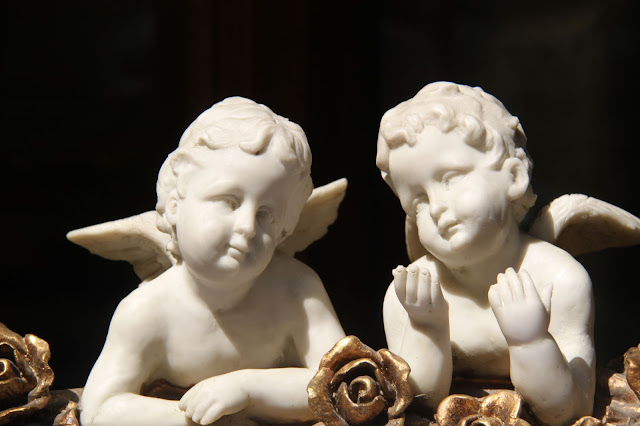Before the new facade was completed the church did not look anything like as impressive.
The church, which is enormous, has an amazing collection of art, sculpture and stained glass, but they are beyond the scope of this blog.
One of the more fascinating aspects of Santa Croce is that it became "the" place to be buried or at least have a memorial if you were anyone of importance in Florence. The floor and walls are covered with gravestones and memorials. A interactive plan of these tombs is provided on the website of the Opera di Santa Croce.
Obviously most of the gravestones are on the floor and are often very well preserved.
Not surprisingly, one of the largest tombs is that of Michaelangelo:
You will note that he merits a few angels (see previous blog)!
There is also a more sobre memorial to Dante:
Dante actually benefits from double billing as his statue stands just outside the church.
What is more fascinating is the presence of memorials to some characters who were definitely "persona non grata" with the church in their lifetimes.
Galileo has a fine memorial, although you should note that the angels in top right hand corner of the picture below come from a wall painting that was partly covered over by his tomb.
The presence of this memorial would seem strange because Galileo spent more than eight of the last years of life under house arrest (1633-1642). After having been threatened with torture, he was condemned by the Inquisition as "vehemently suspect of heresy" for the heinous crime of believing Copernicus' crazy idea that the earth and planets move round the sun, an idea that was clearly false and contrary to Holy Scripture. Publication of all his existing writings and of any writings that he might make in future was banned and this prohibition was in force until 1835. It was not until 1979, that the papacy finally admitted that the church might have been erroneous in its treatment of Galileo.
Another apparent miscreant who managed to get a memorial in Santa Croce was Machiavelli.
In his works, Machiavelli clearly expressed his opinion that religions were man-made cults. He said that Christianity saps the vigor from men required for an active civic life, but saw that religions could be a good thing as they helped keep the masses subservient to their rulers. His major work "Il Principe - The Prince" was written in 1513 but was not fully published until after his death. Not surprisingly, it was added to the Holy Index of Prohibited Books. Yet here he is in state in Santa Croce.
One deserving person who surprisingly has a memorial at Santa Croce is Florence Nightingdale, the Lady with the Lamp, the nurse and teacher, known for her work during the Crimean War and for founding the first teaching nursing school at Saint Thomas' Hospital, London.
Not only was she named Florence, but she was also born in Florence, so can be claimed as a great personality of Florentine history. The only mystery is why is her memorial relegated to the cloisters instead of being with the other "greats" in the church? Is is because she was an Anglican, or perhaps because she was a woman?
To return to the builder of the facade, Niccolo Mattas. He was selected even though he was a Jew. He wanted to be buried inside Santa Croce alongside the other famous personalities. However, this was not considered appropriate because of his religion so he was buried just outside the door.
However, it would seem that Niccolo had the last laugh as his design incorporated the Star of David in the topmost position!



















































